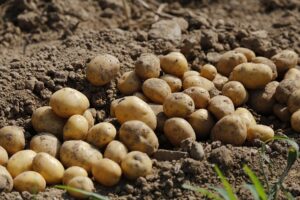Introduction
When to plant potatoes requires careful consideration of the timing and the selection of the right cultivar. The timing is crucial because potatoes are a cool-season crop and planting them at the wrong time can significantly impact the quality and yield of the harvest. Equally important is choosing the appropriate potato cultivar, as different types have varying growth periods, resistance to diseases, and are suited for specific cooking methods. Therefore, understanding the relationship between the planting time and the choice of cultivar is critical to successful potato cultivation.
Understanding Planting Zones
Planting zones, also known as hardiness zones, are geographically defined areas that categorize regions based on their climatic conditions, particularly the average minimum winter temperature. Each zone represents a range of temperatures; for example, Zone 5 may have a minimum temperature of -20 to -10 degrees Fahrenheit. These zones are crucial to consider when planting potatoes, as they directly impact the growth cycle and yield.
Each potato variety has a specific temperature range where it grows best, and outside of that, the plant could suffer from reduced growth or even fail entirely. Also, the timing for planting potatoes can vary significantly based on the planting zone. In colder zones, potatoes are generally planted in spring, while in warmer zones, they can be planted in late winter for a spring harvest or in late summer for a fall harvest. Understanding your planting zone helps ensure that you plant your potatoes at the right time for optimal growth and yield.
Potato Cultivars by Zone
Zone 1-3: Guide for Cold Climates
When cultivating potatoes in Zones 1-3, it’s crucial to select cultivars that can withstand the harsh, frost-ridden climate. Highly recommended are the Adirondack Blue and Yukon Gold varieties. These types of potatoes are favored due to their hardiness and adaptability to cooler environments.
The suggested planting dates for these zones are during the late spring. This timing allows the tubers to grow during the slightly warmer summer months, without exposing them to the early spring frost that is typical in these zones. However, local weather conditions should also be considered, and adjustments should be made accordingly. Always ensure that the soil temperature is above 45°F, as potatoes will not start to grow until the soil reaches this temperature.
Zone 4-6: Guide for Temperate Climates
When planting potatoes in Zones 4-6, the recommended cultivars are Kennebec and Russet Burbank. These varieties are well-suited for temperate climates as they can tolerate the moderate conditions and have been found to produce a high yield in these zones.
The suggested planting dates for these zones are mid to late spring. This timing provides the tubers with the ideal growing conditions – after the risk of frost has passed, yet early enough to take advantage of the full growing season. As with colder zones, it’s essential to monitor local weather conditions and adjust planting times as necessary. Remember, potatoes will not begin to grow until the soil temperature is at least 45°F. Always ensure the soil has reached this minimum temperature before planting.
Zone 7-10: Guide for Warmer Climates
In warmer climates, such as those found in Zones 7-10, the potato varieties that perform best include Red Pontiac and Yukon Gold. These types are particularly resistant to heat and have been proven to give a solid yield in these zones.
The recommended planting times for these zones are early to mid-spring, allowing the plants to grow throughout the warmer months and avoid the peak summer heat. However, as always, pay close attention to local weather conditions and adjust the planting times accordingly.
In terms of planting techniques, it’s advised to plant potatoes in ridges or raised beds. This not only improves drainage – crucial in warmer climates to prevent rotting – but also makes it easier to add compost or leaf mold, which will help keep the soil cool and moist.
Soil preparation is crucial for a successful yield. For optimal plant growth, it is crucial to have well-draining soil that is abundant in organic matter. Prior to planting, incorporate a generous amount of compost or well-rotted manure to enhance the organic composition of the soil. This will ensure that your plants thrive and flourish to their fullest potential.
Ongoing care is also essential for potato growth. Proper watering is essential, especially in dry periods. However, be cautious not to overwater the soil as it can cause tuber rot. To retain soil moisture and prevent weed growth, consider using mulch.. Regularly check your potato plants for signs of pests and diseases, and take action immediately if any are spotted. With the right care and attention, you can enjoy a bountiful harvest from your potato plants in these warmer climates.
Conclusion
In conclusion, the success of potato cultivation, especially in warmer climates, hinges on two crucial factors: proper timing and appropriate cultivar selection. The selection of heat-resistant varieties like Red Pontiac and Yukon Gold is instrumental in ensuring a robust yield in these climates. Couple this with the recommended planting times of early to mid-spring, and growers can help their plants cope with peak summer heat. However, it’s always wise to monitor local weather conditions and adjust planting times as required. The essence of these guidelines is to underscore that both the timing and type of potato planted significantly influence the overall success and yield of the crop. By making informed decisions about these factors, growers can maximize their harvest potential and enjoy the fruits of their hard work.
POTATO GROWING GUIDE
| Temperature | For Germination
65 -70 F |
Days to Germination
|
For Growth
>70F |
| Care | Fertilizer; Light feeder
Use Compost when planting and again 3 weeks post hilling as side dressing |
pH 5 – 6 | Water: Heavy when potatoes are forming |
| Size
|
Planting Depth
3 -4” |
Root Depth
18 – 24” |
Height
24 – 30” Width 24” |
| Spacing | Between Plants
9 -12 “
|
Between Rows
12- 18” |
Plants per Person
10-30 |
| Harvest | 10 weeks after planting new potatoes.
17 weeks for regular potatoes Dig when dry |
Gently pull out or use broad fork
If not ready cover with soil for another 3 weeks |
For storage potatoes dig when plants have died back |
| Seed starting indoors
Seed starting outdoors |
14 – 28 days before 1st frost
90 – 120 days before 1st frost |
Last date to sow outdoors:
90-110 days before 1st frost |
|
| Companion Plants
Brassicas, corn, marigolds, pigweed |
Incompatible
Cucumbers, pea, pumpkin, raspberry, spinach, squash, sunflower, tomato |
Seed viability
Several years Tuber seed for 6-9 months |


